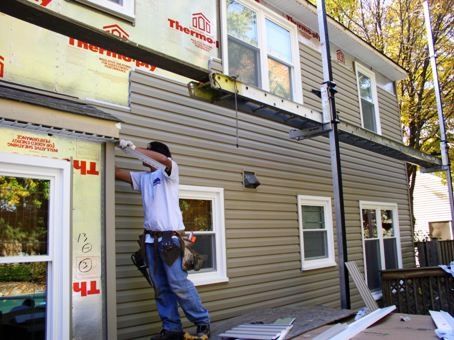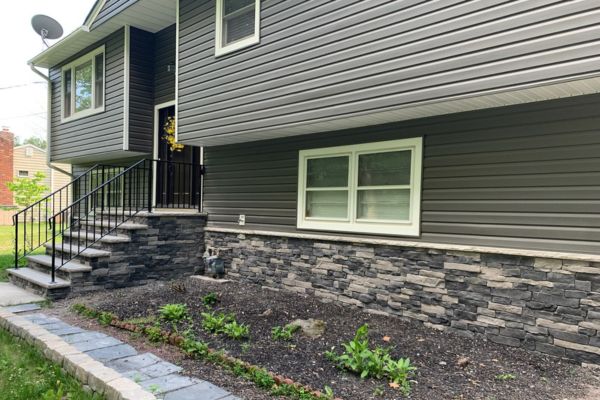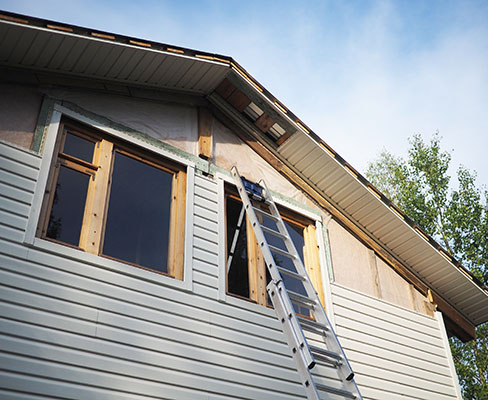The Important Overview to the Numerous Kinds of Home Siding and Their Distinct Advantages
In the world of home enhancement, selecting the right house siding is a critical choice that affects both visual allure and useful efficiency. With so lots of options to consider, which house siding material genuinely stands out for your specific project?
Timber House Siding
Wood exterior siding, a preferred option for residential exteriors, offers an ageless aesthetic that incorporates natural elegance with architectural honesty. This house siding material is readily available in different styles, including clapboard, roof shingles, and board-and-batten, allowing property owners to tailor their appearance to match their style choices. Wood home siding is normally crafted from resilient species such as cedar, redwood, or ache, which are recognized for their durability and capability to withstand environmental stress factors.
One of the main advantages of wood siding is its excellent insulation homes, which can add to power efficiency and reduced home heating expenses. Additionally, timber exterior siding is naturally degradable, making it an environmentally friendly alternative when sourced sustainably. Regular maintenance, including painting or staining, can extend its lifespan and improve its appearance, permitting house owners to maintain the all-natural charm of the timber.
However, possible downsides include vulnerability to bugs, rot, and weather damages, requiring sufficient treatment and maintenance - morris siding contractor. Despite these worries, when appropriately cared for, timber exterior siding can offer a attractive and resilient remedy that enhances the personality of a home while supplying a cozy, inviting ambience

Vinyl House Siding
Vinyl home siding has actually emerged as a leading selection for house owners seeking a low-maintenance outside alternative that incorporates durability and cost. This versatile material is crafted from polyvinyl chloride (PVC), making it resistant to numerous weather, consisting of wetness and UV rays. Therefore, vinyl exterior siding does not warp, rot, or discolor, making certain lasting visual charm.
One of the main advantages of vinyl siding is its considerable series of designs and colors, allowing home owners to accomplish the wanted seek their building without the demand for constant repainting. In addition, plastic siding is very easy to mount, which can dramatically lower labor costs throughout construction or renovation projects.
Vinyl home siding likewise contributes to power performance. Numerous options attribute insulation support, which improves thermal efficiency, assisting to preserve comfy indoor temperature levels and possibly decreasing energy expenses. Additionally, its smooth surface helps with simple cleaning, needing only regular cleaning with a yard pipe to get rid of dust and particles.
Fiber Concrete Home Siding
Fiber cement siding has obtained grip among building contractors and house owners alike as a result of its exceptional combination of sturdiness and visual flexibility. Composed of a mixture of concrete, sand, and cellulose fibers, this siding choice is engineered to hold up against extreme weather condition problems, including high winds, heavy rain, and temperature level changes, making it a lasting choice for household outsides.

Among the key advantages of fiber cement house siding is its resistance to bugs, such as termites, and its non-combustible nature, offering enhanced fire security. morris siding contractor. In addition, it is offered in a vast array of textures, designs, and shades, permitting homeowners to accomplish their preferred visual without compromising performance
One more benefit is its low upkeep needs; fiber concrete home siding usually calls for painting or discoloration every 5-10 years, which is much less regular than other products. Additionally, its long life adds to a reduced total price of possession, as it minimizes the requirement for regular fixings or substitutes.
Ultimately, fiber concrete siding stands for a superb investment for those looking for a resilient, attractive, and flexible outside alternative, combining both type and feature to improve the home's curb charm.
Metal Siding
The appeal of metal siding depends on its robust toughness and modern aesthetic allure, making it a preferred option for contemporary architecture. Readily available in materials such as aluminum and steel, steel siding uses a variety of colors and finishes, enabling homeowners to achieve a customized look that matches their layout vision.

Energy efficiency is another significant benefit, as lots of steel house siding items are made with insulation choices that aid control indoor temperatures. This can cause lowered power prices over time. In addition, steel house siding is commonly recyclable, making it an ecologically pleasant choice for sustainability-minded homeowners.
The setup process for metal house siding can be relatively straightforward, causing a quicker turn-around time for construction jobs. In general, steel home siding combines functionality and design, making it a sensible alternative for those seeking a aesthetically enticing and long-lasting exterior coating.
Brick and Rock House Siding
Block and rock siding stands apart as a classic selection that improves the aesthetic appeal of like this any home. Known for their durability and reduced upkeep, these materials provide a phenomenal roi while raising the building's visual allure. Readily available in various colors, structures, and patterns, brick and stone can be tailored to fit varied building styles, from standard to contemporary.
One of the main benefits of block and stone exterior siding is their power performance. Both materials possess all-natural protecting residential properties that assist regulate indoor temperatures, possibly minimizing heating and air conditioning costs. Additionally, they supply premium fire resistance contrasted to various other exterior siding choices, adding to boosted security.
One more benefit is their long life. Brick and rock can last for years, commonly needing marginal upkeep beyond periodic cleaning. Unlike timber home siding, they are unsusceptible insects and rot, ensuring a resilient outside that endures the elements.
Verdict
In recap, the selection of home siding considerably affects a home's visual charm, energy performance, and maintenance requirements. Each sort of house siding-- whether timber, plastic, fiber block, steel, or concrete and stone-- uses special benefits customized to numerous house owner choices and ecological problems. Understanding these alternatives makes it possible for informed decisions that improve Read Full Article both the durability and visual appeal of property exteriors. Inevitably, selecting the best exterior siding is vital for achieving a balance between capability and design in domestic style.
One of the key advantages of wood home siding is its outstanding insulation homes, which can add to power efficiency and reduced heating prices. Furthermore, wood siding is naturally degradable, making it official website an eco friendly option when sourced sustainably.One of the primary benefits of steel exterior siding is its resistance to numerous ecological elements.Power performance is another substantial benefit, as many steel house siding items are designed with insulation options that aid control indoor temperature levels. Each type of exterior siding-- whether timber, plastic, fiber brick, cement, or metal and rock-- uses distinct benefits customized to various property owner choices and environmental conditions.